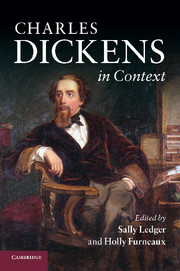Book contents
- Frontmatter
- Contents
- List of illustrations
- Notes on contributors
- Preface
- Notes on references
- PART I LIFE AND AFTERLIFE
- PART II SOCIAL AND CULTURAL CONTEXTS
- 12 Popular culture
- 13 The rise of celebrity culture
- 14 The newspaper and periodical market
- 15 Authorship and the professional writer
- 16 The theatre
- 17 Melodrama
- 18 The Bildungsroman
- 19 Visual culture
- 20 The historical novel
- 21 The illustrated novel
- 22 Christmas
- 23 Childhood
- 24 Work
- 25 Europe
- 26 The Victorians and America
- 27 Educating the Victorians
- 28 London
- 29 Politics
- 30 Political economy
- 31 The aristocracy
- 32 The middle classes
- 33 Urban migration and mobility
- 34 Financial markets and the banking system
- 35 Empires and colonies
- 36 Race
- 37 Crime
- 38 The law
- 39 Religion
- 40 Science
- 41 Transport
- 42 Illness, disease and social hygiene
- 43 Domesticity
- 44 Sexuality
- 45 Gender identities
- Further reading
- Index
26 - The Victorians and America
Published online by Cambridge University Press: 05 August 2012
- Frontmatter
- Contents
- List of illustrations
- Notes on contributors
- Preface
- Notes on references
- PART I LIFE AND AFTERLIFE
- PART II SOCIAL AND CULTURAL CONTEXTS
- 12 Popular culture
- 13 The rise of celebrity culture
- 14 The newspaper and periodical market
- 15 Authorship and the professional writer
- 16 The theatre
- 17 Melodrama
- 18 The Bildungsroman
- 19 Visual culture
- 20 The historical novel
- 21 The illustrated novel
- 22 Christmas
- 23 Childhood
- 24 Work
- 25 Europe
- 26 The Victorians and America
- 27 Educating the Victorians
- 28 London
- 29 Politics
- 30 Political economy
- 31 The aristocracy
- 32 The middle classes
- 33 Urban migration and mobility
- 34 Financial markets and the banking system
- 35 Empires and colonies
- 36 Race
- 37 Crime
- 38 The law
- 39 Religion
- 40 Science
- 41 Transport
- 42 Illness, disease and social hygiene
- 43 Domesticity
- 44 Sexuality
- 45 Gender identities
- Further reading
- Index
Summary
Shortly before departing for the United States, Dickens wrote a letter to the New York magazine editor Lewis Gaylord Clark in which he voiced his eager anticipation of his trip: ‘I cannot describe to you the glow into which I rise, when I think of the wonders that await us, and all the interest I am sure I shall have in your mighty land’. Accompanied by his wife Catherine, Dickens set sail from Liverpool on 4 January 1842, reaching America on the 22nd. His six-month itinerary included the cities of Boston, New York, Washington, Cincinnati and Philadelphia; inspections of America's institutions – its prisons, asylums, homes for the blind, schools and the seats of government; and trips in search of nature, visiting the Prairie and Niagara Falls and witnessing American frontier life on the banks of the Mississippi as he travelled down the river by paddle steamer.
Within a mere eight weeks of his arrival, however, Dickens fired off a very different kind of letter to his actor friend Charles Macready in London. ‘This is not’, he famously declared, ‘the Republic I came to see. This is not the Republic of my Imagination.’ Commissioned in advance to write an account of his trip, on his return to England Dickens produced a travelogue, American Notes for General Circulation (1842), in which praise of certain institutions and customs of the fledgeling republic was outweighed by wide criticism.
- Type
- Chapter
- Information
- Charles Dickens in Context , pp. 211 - 218Publisher: Cambridge University PressPrint publication year: 2011
- 1
- Cited by



